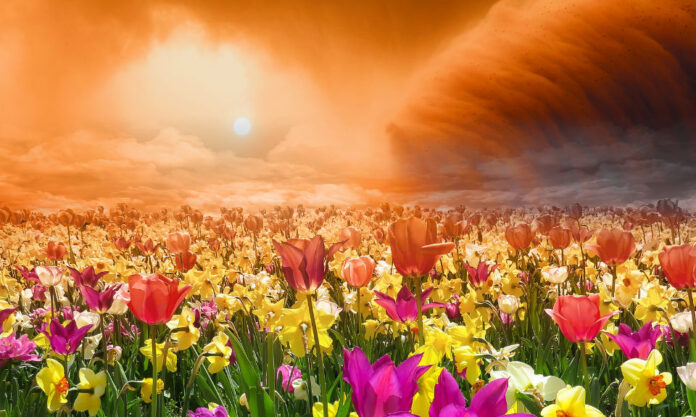“… the bright sun was extinguish’d, and the stars did wander darkling in the eternal space”
So begins “Darkness” by Lord Byron, a Romantic era poem that takes a lyric wandering through an end-of-days scenario where all light and colour is drained from the world.
Not a single colour is named, unless you count black; instead we are offered glimpses of a world gone mad, of “bones… tombless as their flesh”, of “birds and beasts and famished men”, of an “icy earth… blind and blackening in the moonless air”.
The poem was composed during the “Year Without a Summer”, a time when global temperatures dropped due to eruption of Mount Tambora in Indonesia in 1815. This resulted in worldwide weather abnormalities, and crop failures across Europe and North America. Combined with the fallout from a series of recent conflicts including the Napoleonic Wars, the poem captures a feeling of despair and hopelessness that many people felt during that time of darkness and uncertainty.
It’s a rollicking read, offering arresting images of destruction, destitution and the lengths people can be driven to when the means of food production are taken away from them.
It is, also, perhaps not too unbelievable as the end game of a world without colour, without sunlight, without warmth. I am reminded of a recent sandstorm over Nanjing, which, while less extreme in its effects than Byron’s consumed cities, still offered us a “dull sky” awash with dust.
The effect was disconcerting. Just the previous day I had commuted in and out of work with a light heart, lifted by the brightening mornings.
The grass was spring green, the sky a soft and serene pale blue. The Niushoushan River sparkled a twinkling gold in my eye, too bright to look at full on.
I was consciously aware of the rise in spirits the colours brought me.
Then the very next day I left under a literal cloud of gloom. While mercifully brief, the absence of colour and light on my commute home had as much a conscious effect on my spirits as its presence had in reverse. I was grumpy, impatient and a little more liberal with my e-bike horn than normal.
It is no secret, then, that colour holds immense power to evoke emotion, influence mood and communicate meaning. Colours are used across the spectrum (sorry) in art, business branding, fashion, advertising, and tourism, and often hold significant cultural and symbolic meaning.
Cultures with significant history to draw upon tend to gather associations around colours that can be opaque (forgive me again) or hard to make out to outsiders. Sometimes these associations have direct historical links. Yellow, for example, was once reserved for the Emperor, and anyone else caught wearing it was subject to punishment. In Europe, purple was the colour of royalty and power, and was off limits to those of lower social status.
These days, wearing a green hat is an unthinkable colour faux pas here in the Middle Kingdom. Explanations why vary, with one theory stating that back in the Yuan dynasty, relatives of prostitutes were forced to wear green hats. While the provenance of the symbol is murky, the meaning isn’t. It has a European counterpart also, in the Shakespearian era idea of wearing antlers on your head; you are a victim of infidelity by your significant other.
Some use of colour is more universal. There are few more recognisable symbols than traffic lights; green to go, yellow for caution and red to stop. And thank the colour gods for this worldwide adoption! A less vital but no less useful colour usage is brown for a tourism road sign. I was pleasantly surprised to see this hold true in China as well as my native Britain.
These uses of colour are arguably arbitrary, or at least don’t seem to be deeply tied to any sort of objective or biologically-led effect of the colour itself. But much research has been conducted on the effect of colour on humans, with “warm” colours such as red, orange and yellow being able to create a sense of excitement. Branding companies and advertising agencies are well aware of this. Think how many fast-food companies use red and yellow in their logos and décor to create a sense of urgency and energy. I’m willing to bet you can think of least one!
Meanwhile “cool” colours like blue, green and purple can have a calming effect and are used for relaxation. But blue has also been described as conveying trust, loyalty, cleanliness and understanding. To throw a third splash onto the palette (last time!), blue also has a long and established tradition as the colour of depression, loneliness and pain, especially in American blues music, or when someone is “feeling blue”.
So which is it? Can one colour really communicate all these disparate concepts and emotions? Or is there something else going on here?
The answer, as ever, is; it depends. It depends on context, background, and history. While blue may signify the sky and immortality to some cultures, it might equally signify sadness and melancholy to others. It seems colour cuts across biology, psychology, and culture to pick up meanings and associations like a chameleon.
I’d like to keep things simpler. While it may be ambitious to wish for a technicolour commute every morning in to school, I do hope the days when I’m subjected to apocalyptic dust clouds are few and far between. Let’s move from the colourless void of Byron’s darkness to another Romantic poet, William Wordsworth, and his celebration of colour in all its impactful beauty:
“I wandered lonely as a cloud
That floats on high o’er vales and hills,
When all at once I saw a crowd,
A host, of golden daffodils…”









